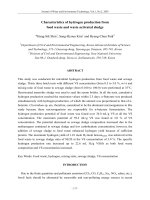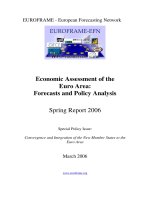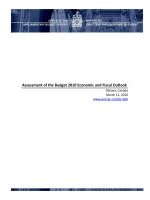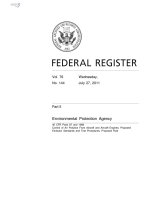Environmental impacts assessment of biodiesel production from Jatropha and WCO
Bạn đang xem bản rút gọn của tài liệu. Xem và tải ngay bản đầy đủ của tài liệu tại đây (550.37 KB, 11 trang )
Vietnam Journal of Science and Technology 57 (5) (2019) 606-616
doi:10.15625/2525-2518/57/5/13371
ENVIRONMENTAL IMPACTS ASSESSMENT OF BIODIESEL
PRODUCTION FROM JATROPHA AND WCO
Dinh Sy Khang1, *, Duong Phuoc Hung2, Phan Dinh Tuan1
1
HoChiMinh City University of Natural Resource and Environment
236B Le Van Sy St., District Tan Binh, Ho Chi Minh City
2
Ministry of Natural Resources and Environment,
10 Ton That Thuyet, Cau Giay District, Ha Noi
*
Email:
Received: 11 December 2018; Accepted for publication: 20 August 2019
Abstract. Viet Nam has advantaged conditions to produce renewable energy from agriculture
products and agriculture waste. Biodiesel that is produced from renewable resources has been
rising as a promising candidate to replace conventional energy in recent decades. However,
developing biodiesel from agricultural product may affect food security significantly. Therefore,
Jatropha that is inedible and wasted-cooking-oil (WCO) could be considered to produce
biodiesel in order to diversify the biodiesel sources. One of the most important aims of using
biodiesel to replace fossil diesel is to reduce environmental impacts, particularly impact on
Climate Change. It is necessary to analyze the environmental performance of biodiesel through
the entire life cycle. In this paper, life cycle assessment of biodiesel production and use was
applied to measure the environmental performance of biodiesel produced from Jatropha oil and
WCO under Viet Nam conditions. Some main emissions, such as CO2, NOx, PM, CH4, VOC and
land use, were computed through a cradle-to-grave analysis. The result shows that when using
Jatropha biodiesel to replace diesel, global warming potential (GWP) and photochemical oxidant
formation potential (POFP) could be improved, but some other impacts, such as acidification
potential (AP) and eutrophication potential (EP), could tend to increase. The environmental
impacts of WCO biodiesel are all reduced in comparison with fossil diesel.
Keywords: life cycle assessment, environmental impacts, biodiesel, Jatropha, waste cooking oil.
Classification numbers: 3.2.1, 3.4.1, 3.5.1.
1. INTRODUCTION
The demand of energy has been increasing rapidly while fossil fuel resources are not
unlimited. Moreover, the global problems, such as global warming and environmental pollution,
are rising with industrialization. So it is imperative to develop alternative resources of energy.
Renewable energy has played an important role in improving energy security and environmental
problem at global and national scales. Biodiesel is a renewable fuel could substitute conventional
diesel to run engines directly or in blending with diesel [1]. Biodiesel has been recently produced
Environmental impacts assessment of biodiesel production from Jatropha and WCO
and used commonly in some countries, such as USA, Brazil, China, Indonesia, Philippines etc.
Using biodiesel as alternative fuel of fossil fuel may reduce the consumption of energy and
obtain positive environmental impact by reducing the gases emissions. Most biodiesel is
produced from edible oil such as soybean, mustard, coconut, and sunflower oil [2]. However,
food security is a major concern when we choose the edible oil for biodiesel production. So it is
necessary to expand the raw material for biodiesel production to non-edible oil or wasted oil.
Jatropha curcas and wasted-cooking-oil (WCO) that could be used to produce biodiesel are
sustainable development of this energy resource.
Viet Nam has provided a policy to produce biodiesel from Jatropha to replace diesel in the
near future according to the Decision No. 1842/QD-BNN-LN of Vietnamese government [3].
Initially, from the experiences of biodiesel projects, this material could be developed in Viet
Nam. Moreover, Viet Nam market also releases a large amount of wasted oil from activities of
restaurants, hotels, and food productions. These are potential sources to produce biodiesel in
near future. Viet Nam, with 21 percent of the total area usable in agriculture, has advantage to
produce biodiesel from agricultural product or waste. Besides, Jatropha could be introduced in
uncultivated or impoverished lands to avoid using the lands used for food production. So the
inedible oil from Jatropha may be an appropriate material for biodiesel production. Viet Nam has
promoted biodiesel as an alternative of conventional fossil fuel. There are many studies of
biodiesel that have been conducted with specific conditions in Viet Nam. However, most studies
on biodiesel have focused on technological aspects of biodiesel production. Another study on
environmental impact should be completed to make a comprehensive overview of Jatropha and
WCO biodiesel. This study carried out the investigation on the environmental impact of
biodiesel in Viet Nam.
There are some studies on Jatropha and WCO biodiesel performed in several countries,
such as Thailand [4], Malaysia [5] and India [2] showing the reduction of greenhouse gas.
However, different condition of biodiesel production may result in different environmental
impacts. It is necessary to measure the environmental performances of biodiesel from Jatropha
based on the current conditions of Viet Nam. Life cycle assessment (LCA) is the most widely
method for quantitative assessment of materials, energy flows and the environmental
performance of products or technology from its cradle to grave. LCA is designed to evaluate
input-output and potential environmental impacts of product from cradle-to-grave. LCA also has
been applied to compare the processes based on different conditions, models, scenarios. It is
used to define and reduce the environmental burdens from a product by identifying and
quantifying energy and materials usage and waste discharges, assessing the impacts of the
wastes on the environmental improvement over the whole life cycle. The environmental impacts
of this product under the conditions of Viet Nam has been assessed in few studies, such as [6].
2. METHODOLOGY
2.1. Life Cycle Assessment
This study is to quantify the environmental impacts issued from biodiesel production and
use from Jatropha under Viet Nam conditions. The comparison of some environmental impacts
between biodiesel and fossil diesel was performed. LCA was chosen as the methodology to
measure the environment impacts in this study. This is an international standardized
methodology gathering the relevant inputs and outputs of product system. The total
environmental impacts are measured by LCA according to the standard described in ISO 14040
607
Dinh Sy Khang, Duong Phuoc Hung, Phan Dinh Tuan
shown in Figure 1. LCA method includes four steps: goal and scope definition, inventory
analysis, impact assessment, and interpretation [7].
Goal and scope
definition
(ISO 14041)
Inventory analysis
(ISO 14041)
Interpretation
(ISO 14043)
Impact assessment
(ISO 14042)
Figure 1. Life cycle assessment framework.
Oil production
- Jatropha plantation
- Jatropha seed production
- Jatropha oil extraction
Transportation
Biodiesel conversion
- Oil treatment
- Transesterification
- Biodiesel purification
Transportation
Biodiesel use
(Producing 1MJ)
Figure 2. Life cycle of Jatropha biodiesel production and use.
608
Environmental impacts assessment of biodiesel production from Jatropha and WCO
2.2. System boundary
The system boundary of Jatropha and WCO biodiesel is shown in Figure 2 and Figure 3,
respectively. Life cycle boundary in this study is from the raw material production to fuel
combustion in vehicle engine. The life cycle of biodiesel is from Jatropha farming and ends with
producing 1 MJ of power from biodiesel. It includes stage of oil production for Jatropha and oil
collection for WCO, transportation, biodiesel production and biodiesel use. The first stage is
decomposed to sub-stages: Jatropha plantation, harvesting and oil extraction; biodiesel
production consists of oil treatment, transesterification (biodiesel conversion) and biodiesel
purification; and finally biodiesel was considered to use run engine to produce power. Jatropha is
planning in some selected farms in provinces of Tay Ninh, Binh Thuan, and Ninh Thuan under
Vietnamese government’s projects. The condition of Jatropha plantation is based on [8]. For
WCO biodiesel production, oil could be collected from hotels, restaurants, or food production.
WCO is considered as a waste. The system boundary of WCO biodiesel production consists of
oil collection, biodiesel conversion, transportation, and biodiesel use.
WCO collection
Biodiesel conversion
- Oil treatment
- Transesterification
- Biodiesel purification
Transportation
Biodiesel use
(Producing 1MJ)
Figure 3. Life cycle of WCO biodiesel production and use.
2.3. Goal and scope definition
The objectives of this study are to analyze the environmental impacts of life cycle biodiesel
from Jatropha and WCO based on the conditions in Viet Nam. The life cycle impact assessment
evaluates potential environmental impacts and estimates the resource used. The ratio of
biodiesel/diesel blending was verified from 10 % to 100 %. The following impacts categories
have been assessed:
Global warming potential (GWP) is defined as the impact of greenhouse gases emission
that includes the emissions that contribute to global warming, such as CO2, CH4, N2O. The
equivalent amount of carbon dioxide was used to calculate the amount of any gases that has the
same amount of trapped heat. So, the unit of GWP is the number of gram CO2 equivalent
kg/emission.
Acidification potential (AP) refers to acidifying pollutants on soil, ground water, surface
water, biological organisms, ecosystems, and materials. It is the result of increasing hydrogen
609
Dinh Sy Khang, Duong Phuoc Hung, Phan Dinh Tuan
ions (H+) that may cause damage to organic and inorganic in medium. AP includes the emissions
that cause acidification of rain, soil and water, such as SO2, NOx, and NH3. The unit of indicator
result is in g SO2 equivalent/kg emission.
Photochemical oxidant formation potential (POFP) is a main contributor to smog or known
as summer smog. It is the reaction of chemical compounds and sunlight in the presence of
pollutant gases, such as nitrogen oxide or volatile organic compounds (VOC). The unit of this
impact category is the number gram of ethylene equivalents/ emission.
Eutrophication potential (EP) is the impact of exceed amount of micronutrient that contain
nitrogen (N) and phosphorus (P). This may cause hypoxia, the depletion of oxygen in water that
changes the nutrient concentration in lakes, rivers and soil. Ecosystem may lead to decrease the
oxygen levels, because of the additional consumption of oxygen. The eutrophication impact also
includes the emissions of degradable organic matter. The unit of indicator result of this category
is kg PO4 equivalent/kg emission.
These environmental impact potentials are calculated as the sums of the impact potentials
for the emissions of the product system [9]:
EIj = ∑
where: EIj: is the environmental impact category (j); Ei: is the contribution of emission (i);
: is the effect factor of emission (i) on the environmental impact category (j).
The environmental impacts potentials depends how the emissions occur and the
concentration of substances to which they contribute in environment.
2.4. Functional unit
Functional unit is provided as a reference to the inputs and outputs related. In this study, the
functional unit was chosen to be 1 MJ released by engine fueled by Jatropha and WCO biodiesel.
2.5. Data sources
The data of Jatropha farming was collected from the reports of Jatropha plantation projects
in Viet Nam. Other data of oil and biodiesel production were collected from previous published
studies. The data for vegetable oil extraction are from [10]. The data for biodiesel production is
from [11]. The data of electricity sources is from IEA [12]. The data of the emissions from
biodiesel and diesel use are from [13]. The data of CO2 emission of the production of fertilizer
(N, P, K), hexane, methanol and catalyst are from [14-17] .
2.6. Life Cycle Inventory
Table 1 shows the input – output data for four stages of Jatropha biodiesel production based
on the current conditions in Viet Nam. Jatropha plants were farmed in the prepared field with
spacing of 2×2 m (2500 plants/ha) and could be harvested after 4 year. Fertilizers (N, P, K) were
used during growing Jatropha plant. The yield of Jatropha seed is 2733 kg/ha. Hexane solvent
extraction was performed to get oil and determined oil content of Vietnamese Jatropha is 32.2 %.
For biodiesel production, the common technology based catalyzed transesterification of Jatropha
oil and methanol was applied. And the ratio of oil/methanol/sodium hydroxide was referred from
the reports of the biodiesel production projects in Viet Nam. The total distance for transportation
of oil collection and biodiesel distribution assumed in this study is 20 km. The transport mode
610
Environmental impacts assessment of biodiesel production from Jatropha and WCO
with a mileage of 3km/litter was used for oil and biodiesel delivery. A heavy-duty truck with the
capacity of 25 tons and mileage of 3 km/litter of diesel was assumed [2]. The energy content of
biodiesel and diesel is 37.8 and 48.1 MJ/kg, respectively. In this study, Jatropha and WCO
biodiesel was assumed as fuel to run vehicle. Glycerol was assumed as a product can displace
another process.
Table 1. Input – output data of life cycle system of Jatropha biodiesel production.
Stages
Inputs/outputs
Jatropha biodiesel
Input
Oil production/
Collection
N (kg/ha) *
28.8
P2O5 (kg/ha) *
44.1
K2O (kg/ha) *
45
Diesel (MJ)
3.33
Hexane (to atmosphere) (kg)
5.73
Land use (plants/ha) *
2500
Output
NH3 (to atmosphere) (kg)
-3
Transportation
3.53
PO4 (to fresh water) (kg)
0.165
N2O (to atmosphere) (kg)
0.305
NOx (to atmosphere) (kg)
6.37
Biomass (kg/ha) *
2733
Crude oil*
32.2%
Transport distance (km) **
20
Diesel (km/kg)**
3
Input
Transesterification
Biodiesel use
Crude oil (kg) *
1018
Methanol (kg) *
96
Sodium hydroxide (kg) *
7.6
Output
Biodiesel (kg) *
1000
Glycerol (kg) *
93.35
Waste methanol (kg) **
9.6
Using in vehicle
Biodiesel (MJ)
1***
* data was collected from reports of biodiesel production in Viet Nam.** data was assumed. ***
functional unit of the LCA calculation was 1 MJ.
The emissions generated from the processes to produce fertilizer (N, P, K), hexane,
methanol and catalyst are based on the life cycle assessment of these products as shown in Table 2.
The data was integrated with the database of SIMAPRO 8.0 to make LCA calculation [13]
for environmental impacts assessment.
611
Dinh Sy Khang, Duong Phuoc Hung, Phan Dinh Tuan
Table 2. Greenhouse gases emission factor for inventory.
Inventory
GHG emission factor
References
Diesel
3.67
kg CO2/kg
[14]
N
6.67
kg CO2/kg
[15]
K
0.71
kg CO2/kg
[15]
P
0.46
kg CO2/kg
[15]
Hexane
3.93
kg CO2/kg
[16]
Methanol
1.95
kg CO2/kg
[17]
Sodium hydroxide
1.19
kg CO2/kg
[17]
3. RESULTS AND DISCUSSIONS
3.1. LCA results
Figure 4 shows the life cycle emissions inventory of Jatropha biodiesel and the emission of
diesel. Using biodiesel to replace fossil diesel could improve some emissions, such as CO2, PM,
CH4 and VOC but it also increase some other emissions, such as NOx. It is found that overall
CO2 emission, main distribution gas in GHG, could be reduced significantly. These results also
could be used to calculate the emission reduction of national level according to the percentage of
biodiesel and diesel blending.
3.2. Land use
The most considerable problem of using Jatropha as feedstock of biodiesel production is
land use. In this study, it refers to the loss of land or it is unavailable for another purpose. It may
improve the structural ecosystem if it is planted on wasteland but it could affect the functional
ecosystem if it is used to replace other plants. Indirect land-use was not considered for Jatropha
plantation. The land occupation impact of Jatropha in this study was 3.14E-08 ha/MJ that is quite
large for an agriculture country like Viet Nam. In the case of WCO, land use of oil production
stage is assumed as zero. Thus the impact of land use of WCO biodiesel that is allocated to
biodiesel conversion and use stage should be minor. However, the capacity of WCO used in
biodiesel production is not large. So it is necessary to consider the maximum capacity of
biodiesel production or the acceptable percentage of biodiesel blending with diesel.
3.3. Interpretation
The life cycle impacts of biodiesel are shown in Figure 5. It is found that the environmental
impacts of WCO biodiesel are all better than ones of fossil diesel. The main reason is that
environmental impacts of the first stage of oil production the life cycle of WCO are allocated to
the main product. In the case of Jatropha biodiesel, there are different trends of environmental
612
Environmental impacts assessment of biodiesel production from Jatropha and WCO
impact categories when using biodiesel to replace diesel, GWP and POFP could be improved
whereas AP and EP are increased.
VOC
CH4
6.00E-08
2.50E-06
2.00E-06
1.50E-06
1.00E-06
5.00E-07
0.00E+00
4.00E-08
2.00E-08
0.00E+00
WCO
Jatropha
biodiesel biodiesel
Diesel
WCO
biodiesel
PM
Jatropha
biodiesel
Diesel
CO2
3.00E-08
8.00E-02
6.00E-02
4.00E-02
2.00E-02
0.00E+00
2.00E-08
1.00E-08
0.00E+00
WCO
biodiesel
Jatropha
biodiesel
Diesel
WCO
biodiesel
Jatropha
biodiesel
Diesel
NOx
6.00E-04
4.00E-04
2.00E-04
Figure 4. Comparative results of life cycle
emissions of biodiesel and diesel.
0.00E+00
WCO
Jatropha
biodiesel biodiesel
Diesel
Global warming potential: In this study, the GWP of Jatropha biodiesel 1.23E-02 kg CO2
eq./1 MJ based on the conditions in Viet Nam. It could be reduced 86.56 % of the life cycle
GWP of Jatropha biodiesel compared with fossil diesel. The reason of this is the large amount of
CO2 absorbed in biomass growth.
Photochemical ozone foundation potential: This impact category is expressed as kg C2H4
eq. In this study, POFP is associated with the emission of NOx, CH4 and VOC. The result shows
that Jatropha biodiesel could reduce 53.63 % of life cycle POFP compared with fossil diesel.
Acidification potential: AP is calculated as kg SO2 eq. that is associated with the emission
of NH3 and NOx. The result indicates that the life cycle AP of Jatropha biodiesel is higher than
fossil diesel.
613
Dinh Sy Khang, Duong Phuoc Hung, Phan Dinh Tuan
Eutrophication potential: This offers to the emissions to the air, water and soil and is
measured in kg PO43- eq. In this study, EP includes the emission of NH3, NOx and PO4. The
result also indicates that the life cycle EP of Jatropha biodiesel is higher than fossil diesel. It
could be the result of leaking N and P of fertilizer into the water and air.
These negative impacts (AP and EP) could be the results of using fertilizer in Jatropha
plantation. So NH3, NOx, PO43- may emit into the air or fresh water.
GWP
POFP
1.00E-01
8.00E-02
6.00E-02
4.00E-02
2.00E-02
0.00E+00
4.00E-05
3.00E-05
2.00E-05
1.00E-05
WCO
biodiesel
Jatropha
biodiesel
Diesel
0.00E+00
WCO
biodiesel
AP
Jatropha
biodiesel
Diesel
EP
1.00E-03
2.00E-04
1.50E-04
1.00E-04
5.00E-05
0.00E+00
5.00E-04
0.00E+00
WCO
biodiesel
Jatropha
biodiesel
Diesel
WCO
biodiesel
Jatropha
biodiesel
Diesel
Figure 5. The life cycle impacts of biodiesel production and use.
4. CONCLUSIONS
The results of the study showed that replacing fossil diesel by biodiesel could reduce the
gas emissions, such as CO2, PM, CH4 and VOC, but it could increase Nitrogen emissions. There
are some positive impacts as well as some negative impacts issued from Jatropha biodiesel
production and use in replacing fossil diesel. WCO biodiesel has positive impacts on
environment. However, the most challenge of WCO biodiesel development is from the limitation
of the capacity of WCO and the competition with animal feed production. Jatropha biodiesel that
has large capacity could reduce 85.56 % GWP and 53.63 % POFP to fossil diesel although it
could increase EP and AP. So it is necessary to consider every impacts in the decision making of
biodiesel development. And the LCA also indicate the method to reduce the environmental
burden through improving the technologies of material production and biodiesel conversion. For
instance, the main reason of higher acidification potential and eutrophication potential is the
result of the emission of nitrate and phosphate leaking to water resources and ammonia and NO x
emitted to air N and P fertilizer application. So in order to reduce these impacts, one of the
possible methods is improving the technology of plantation to decrease the amount of fertilizer
614
Environmental impacts assessment of biodiesel production from Jatropha and WCO
consumption. From the results of this study, Jatropha and WCO are found as promising
feedstock of biodiesel to substitute conventional diesel in the future in Viet Nam.
Acknowledgment. The research has been supported to collected data by Research Institute for oil and oil
Plants, National Key Lab in Refining and Petro-chemical Technology in Viet Nam. The authors also
would like to thank Japan International Cooperation Agency (JICA) for financial support.
REFERENCES
1.
Tsoutsos T., Kouloumpis V., Zafiris T., and Foteinis S. - Life Cycle Assessment for
biodiesel production under Greek climate conditions, Journal of Cleaner Production 18(4)
(2010) 328-335.
2.
Kumar S., Singh J., Nanoti S. M., and Garg M. O. - A comprehensive life cycle
assessment (LCA) of Jatropha biodiesel production in India, Bioresource Technology 110
(2012) 723-729.
3.
Ministry of Agriculture and Rural Development of Viet Nam - Approval of the scheme:
Research, development and usage products of Jatropha Curcas L. in Viet Nam in the
period from 2008 to 2015 and a vision to 2025. Decision No.1842/2008/QD-BNN-LN of
Ministry of Agriculture and Rural Development of Viet Nam, 2008.
4.
Prueksakorn K., Gheewala S. H., Malakul P., and Bonnet S. - Energy analysis of Jatropha
plantation systems for biodiesel production in Thailand. Energy for Sustainable
Development 14(1) (2010) 1-5.
5.
Lam M. K., Lee K. T., and Mohamed A. R. - Life cycle assessment for the production of
biodiesel: a case study in Malaysia for palm oil versus Jatropha oil. Biofuels, Bioproducts
and Biorefining 3 (6) (2009) 601-612.
6.
Khang D. S., Tan R. R., Uy O. M., Promentilla M. A. B., Tuan P. D., Abe N., and Razon
L. F. - Design of experiments for global sensitivity analysis in life cycle assessment: the
case of biodiesel in Viet Nam, Resources, Conservation and Recycling 119 (2017) 12-23.
7.
Lee K. M., and Inaba A. - Life cycle assessment: best practices of ISO 14040 series,
Center for Ecodesign and LCA (CEL), Ajou University, 2004.
8.
Thinh P. P. - Researching and developing Jatropha as feedstock for biodiesel production.
Project No. 257.10.RD/HD-KHCN, Viet Nam, 2011.
9.
Wenzel H. - Application dependency of LCA methodology: key variables and their mode
of influencing the method, The International Journal of Life Cycle Assessment 3 (5) (1998)
281-288.
10. Song X., Yu J. - Study on cost of oil processing, China Oils and Fats 28 (2003) 62–4.
11. Li C., Jiang L., Cheng S. - Biodiesel: green energy resource, Beijing: Chemical Industry
Press, 2005.
12. IEA,
Global
Engagement,
Key
Stats
for
Viet
Nam,
1974-2016.
( />oduct=electricityandheat), Electricity Information 2019 overview.
13. Nanaki E. A., and Koroneos C. J. - Comparative LCA of the use of biodiesel, diesel and
gasoline for transportation, Journal of Cleaner Production 20 (1) (2012) 14-19.
615
Dinh Sy Khang, Duong Phuoc Hung, Phan Dinh Tuan
14. Sheehan J., Camobreco V., Duffield J., Graboski M., Shapouri H. - Life Cycle Inventory
of Biodiesel and Petroleum Diesel for use in an urban Bus, Final Report, NREL/SR_58024089. US Dept. of Agriculture and US Dept. of Energy, 1998.
15. Woods J., Brown G., Gathorne-Hardy A., Sylvester-Bradley R., Kindred D., Mortime N. Facilitating Carbon (GHG) Accreditation Schemes for Biofuels: Feedstock Production.
Biofuel Assurance Report. HGCA Project MD-0607-0033. Part 1. London, UK, (2008).
16. Buratti C., Moretti E., Fantozz F. - Assessing the GHG emissions of rapeseed and soybean
biodiesel in compliance to the EU renewable energy direct methodology for biofuels,
University of Perugi, 18th European Biomass Conference and Exhibition, Lyon, France,
2010.
17. IPCC, 2006. IPCC Emission Factor Database, Volume 3, Chapter 3.
616









